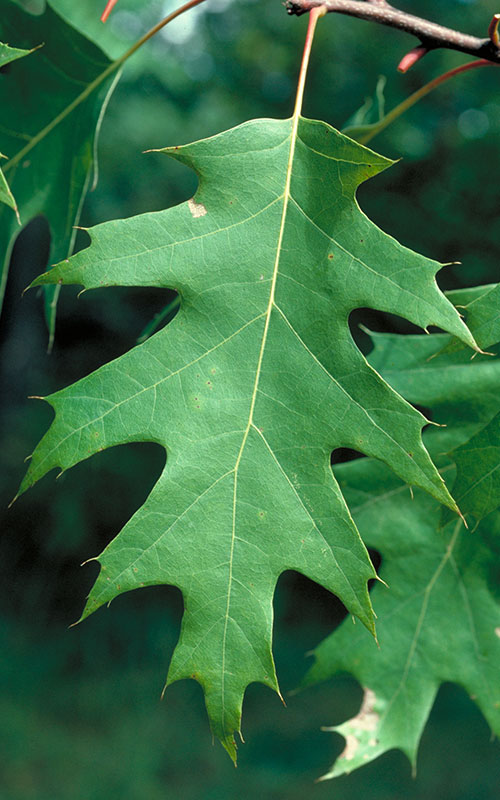Northern Red Oak
(Quercus rubra)
Description
-
A straight and tall tree growing up to 70 to 90 feet tall and “rarely” 130 feet with a trunk diameter of 2 to 3 feet. Can live up to 400 years.
-
Usually has smooth gray bark when young but develops long, flat-topped furrows as it ages. These deep furrows are notable for occurring all the way up and down the trunk. This older version is often referred to as “ski trail” bark!
-
Alternating leaves 4 to 8 inches in length and 4 to 6 inches wide. Each side with 2 to 4 dominant lobes and each of these lobes with 2 to 3 sharp bristle-tipped points. The leaves turn a brilliant red in the fall.
-
Like all oaks, they produce acorns for reproduction. It takes 20 to 25 years before the tree begins to produce acorns. It takes two years for the acorn to develop. The acorn is a jaunty-looking fellow with a bottle-capped hat covering no more than ¼ of the acorn.
Habitat
- Found in the Big Woods alongside the sugar maple the white oak, big tooth, aspen, white pine and birch. It tolerates some shade but prefers six hours of light.
Range
-
Found in all of the US east of the great plains except the Deep South. Extends north into northern Minnesota and southeast and south-central Canada. Prefers well-drained soils with adequate moisture.
History
-
All oaks native to north America share a single common ancestor that originated in Canada some 45 million years ago. The species has broadened out to 220 different types and is now dominant tree for much of North America.
-
Many Native Americans subsisted on red acorns as a primary food source. Rich in starch and fat with a small amount of protein. Once the “bitter tasting” tannin has been removed through a hot or cold-water leaching process, it can be made into flour and dough. Tannin is also found in coffee beans, choke cherries, and even apples.
Current use
-
Valued for its red-tinted hardwood. It is an important timber source. It is used in railroad ties, cabinets, construction, furniture, and flooring.
-
The bark and inner bark are utilized, especially in Native American communities, to treat digestive issues, coughs, fevers. Also used to treat cuts, burns and rashes.
-
The bark with its high tannin amount has been used to soften or tan leather.
-
Many wildlife use the northern red oak acorn for food from bluejays and wild turkeys to gray squirrels, white-tailed deer, mice and even black bears!
Mission
-
Can you identify a Northern Red Oak tree by its distinctive “Ski Trail “bark? Can you see that the trails go up and down the whole length of the trunk?
-
Can you find a Northern Red Oak leaf? Look at it carefully. Count the number of lobes on each side of the leaf. Can you see the bristle tips at the end of the lobe? Can you tell the difference between it and a Basswood leaf or a Maple leaf?
-
Can you find a red oak acorn with its flat top cap that looks like a hat called a “beret “?
-
What animal life uses the acorn as a food source?
-
What other uses does this amazing tree have?
Photo Reprinted with Permission, Minnesota Department of Natural Resources
This page was created by a Master Naturalist volunteer. The Minnesota Master Naturalist program is sponsored by University of Minnesota Extension.






